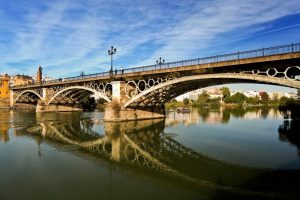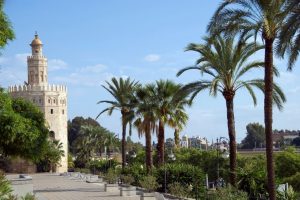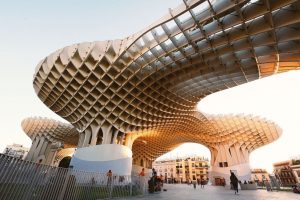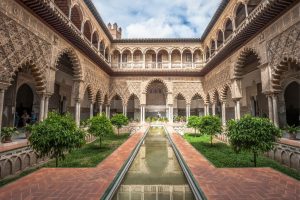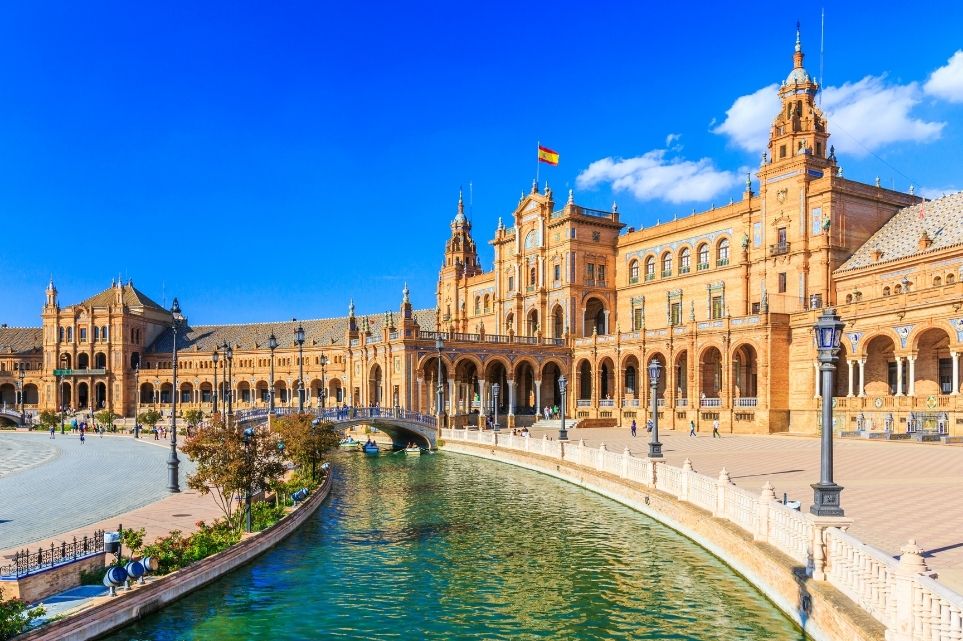
A fun vacation is to visit places where it is festive and full of life, with hopping tapa bars, live music, and tons of sightseeing options.
Seville, Spain, has so much to offer with its gourmet vibes, fancy markets, stunning architecture, and beautiful people. Even though Seville is the state’s capital and fourth-largest city in Spain, it doesn’t feel that way.
Although my visit was short, I covered everything I wanted to see and managed to do it all on foot. Seville is a colorful city with beautiful ornate tiles affixed on historical buildings, flowery landscape parks, and music performers dabbled along the streets. I would say that this is probably one of my favorite cities in Europe.
Without wasting any more time, let us jump right in on what you should see while in Seville.
Royal Alcazar Palace
Take a step back in time and visit one of Seville’s key architectural attractions, the Royal Alcazar Palace. This medieval palace with many lush gardens is stunning. The construction began in the 10th century, home to the ruling Almohad Dynasty. As Christians conquered the Moors, construction continued until the Renaissance period.
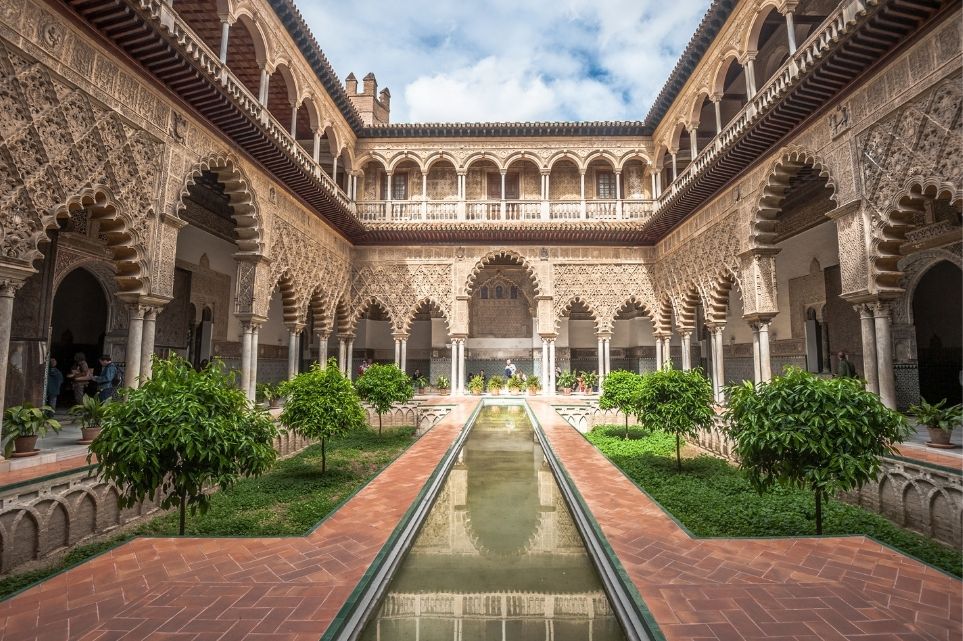
Royal Alcazar Palace
Today it is home to the Spanish royal family, making Europe’s oldest continually used royal palace. Take an audio guide to hear all the details of the magnificent sculptures, paintings, and art pieces inside.
If you are a fan of Game of Thrones, you may notice specific areas inside the palace where they filmed. Lines can be long, so stay away from peak times of the day.
- Hours: Mon. – Sun. 9:30 am – 5:00 pm (schedule may change)
- Fee: $12.00 pp
- Location: Map
- Tour: GetYourGuide
Metropol Parasol
One of Seville’s ultra-modern large structures located in Plaza de la Encarnacion is the Metropol Parasol, nicknamed “las setas” (the mushroom). Built-in 2011, it claims to be the largest wooden structure in the world. The interlocking canopy made from birch wood shades the Plaza from the hot sun in the summer. You will typically find below in Plaza de la Encarnacion open-air markets selling various goods on the weekend. Visitors can go up to an observation point to look down on the structure and the city.
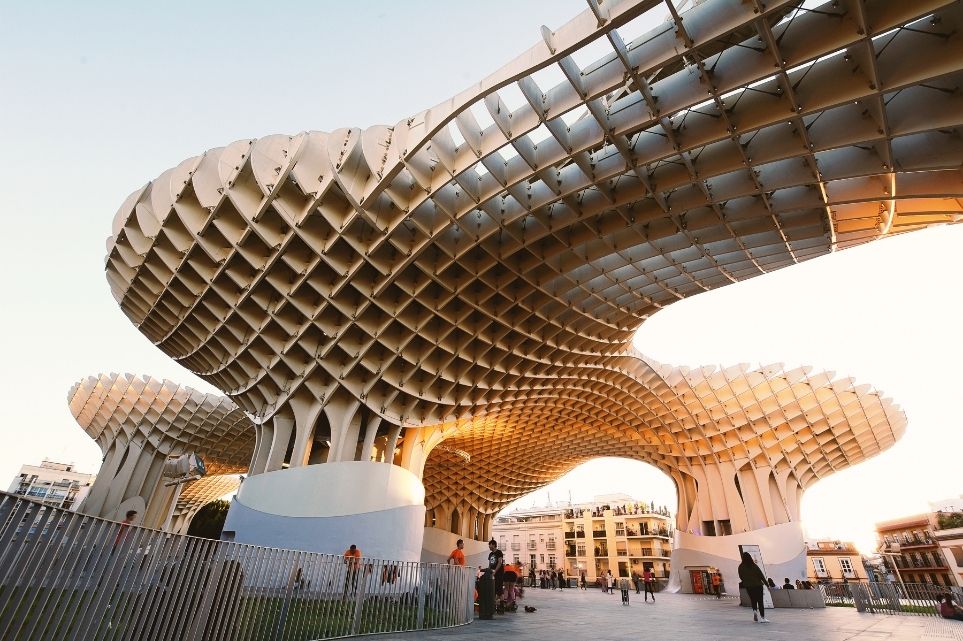
Metropol Parasol
Roman ruins were discovered during the construction, now incorporated into the Museum Antiquarium, which is in the Plaza’s basement. Under the Metropol Parasol, the street level is a food market with over 40 stalls called the Mercado de la Encarnacion. You will find various fruit and vegetables; seafood; game meats; delicatessens, bars, and jewelry.
- Hours: Friday – Saturday: 10 am -11 pm Sunday – Thursday: 10 am -11 pm
- Cost: $ 5 pp to get to the observation level
- Museum Antiquarium hours: Tue. – Sat. 10 am – 10 pm, Sun. 10 am – 2 pm Cost: $3 pp
- Access to the viewpoint is in the basement next to the entrance to the Antiquarium
- The ticket office closes 30 minutes before closing time
- Location: Map; Bus: Ride bus 27 and 32 Metro: T1, stop at Plaza Nueva
- Tours: GetYourGuide
Torre Del Oro
Tale-tells that this tower was once covered in golden tiles, hence receiving the name Torre Del Oro (which means Tower of Gold). As we took a leisurely walk along the Guadalquivir Riverbanks, we came across this hexagonal shape tower.
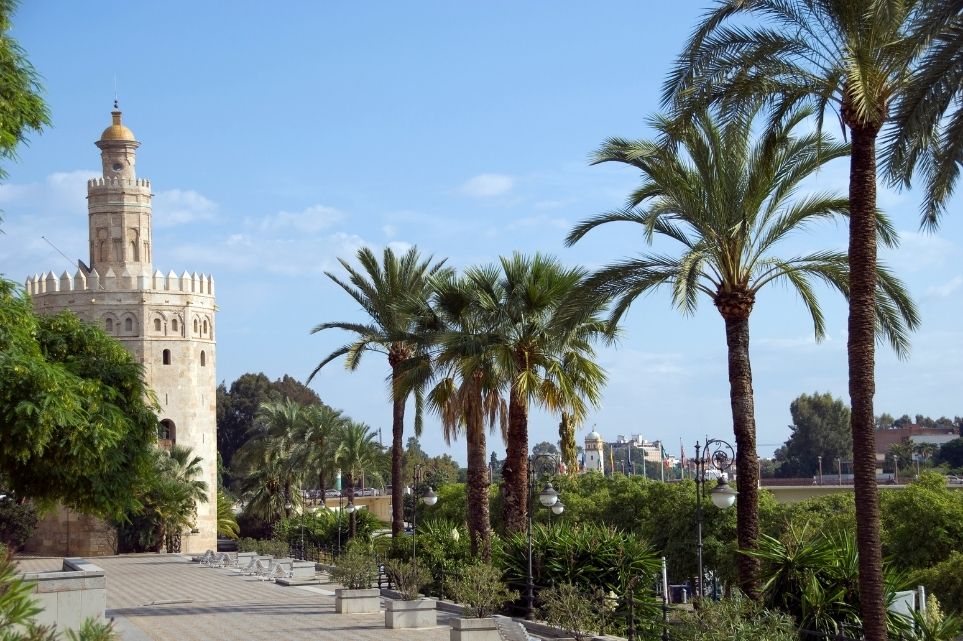
Torre Del Oro
This tower was once used as a military watchtower protecting the Almohad dynasty from invaders. Today it is home to the Navy Museum.
- Hours: Mon. – Fri. 9:30 am – 7 pm, Sat. – Sun. 10: 30 am – 7 pm
- Cost: $5 pp (audio guides are available) Free on Mondays
- Click Map for location. Tram Station: Puerta de Jerez or Bus Station: Paseo Colon (Teatro Maestranza)
- Tours: GetYourGuide
Plaza De Espana and Maria Luisa Park
Not far from the Torre Del Oro is the Maria Luisa Park. This gorgeous city park is worth visiting as the shady trees hang over the walking paths that led you to duck ponds, botanical gardens, decorative monuments, fountains, and colorful ceramic-tile benches.

Plaza De Espana
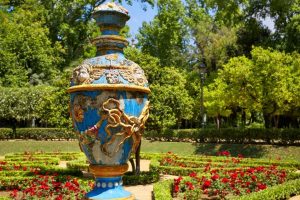
Maria Luisa Park
Two of the city’s leading museums are located here – the Archeological Museum and the Museum of Popular Arts and Traditions.
You will most likely walk through this park to visit the Plaza de Espana. Gorgeous detailed ornate tilework is found throughout the Plaza, crescent-shaped with a relaxing water canal built for the Ibero—American Exposition in 1929. This exhibition was designed to showcase Spain’s art and technology, with complexly filled alcoves representing Spain’s different districts. Your camera will want to capture each nook of colorful tiles depicting the region.
- Hours: 8 am – 10 pm (the best time for photos at 8 am). Give yourself 2 hours to sightsee!
- Cost: Plaza de Espana is free
- Bus Station nearby to Plaza de Espana: Avenida La Borbolla (Capitanía); Avda. Portugal (Ciudad de Ronda), Avenida Maria Luisa (La Raza).
- Tours: GetYourGuide
- Click map for Maria Luisa Park
- Archeological Museum Hours: Mon. – Sat. 9 am – 3 pm; Cost: $5 pp Map:
- Museum of Popular Arts and Traditions Hours: Tue. – Sun. 9 am – 3 pm Cost: $4 pp
Triana (Triana Bridge)
This charming neighborhood is located on the left side of the Guadalquiver River, was once considered a gypsy community. To visit, one must cross the iconic Isabel II’s Bridge, also known as the Triana Bridge, where you will find food carts and other merchants selling various goods. Today this eccentric neighborhood still holds its charm with beautiful churches, ceramic shops, and outdoor tapas bars lining the streets.
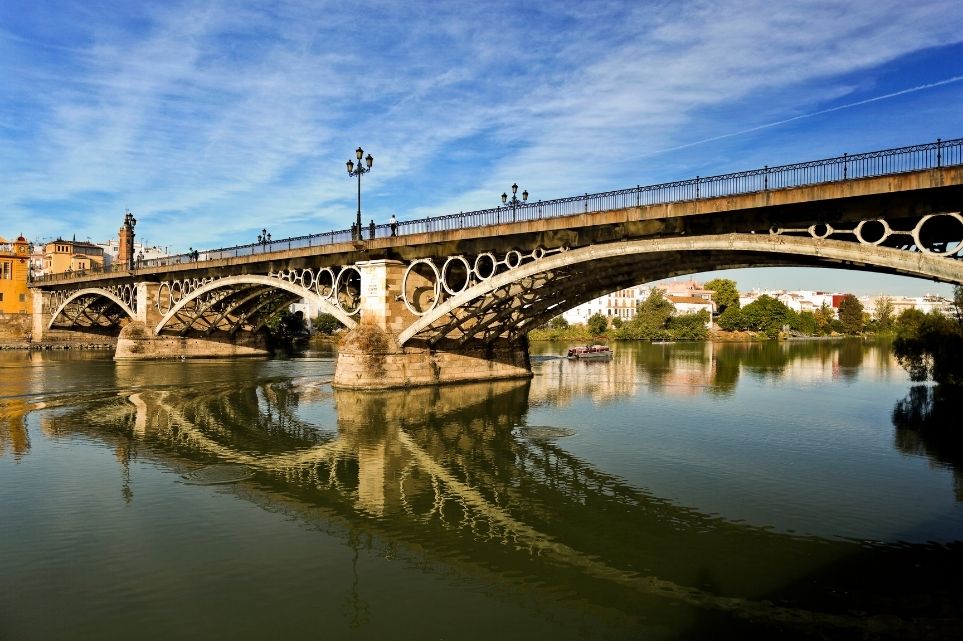
Triana Bridge
Some other interesting sights to see in the area is the Iglesia de Santa Ana, the historic Callejon de la Inquisicion (Inquisition Alley), the Museum of Tolerance located in the San Jorge Castle, and the Santa Ana Pottery Factory. One of our favorite spots we discovered is the Mercado Triana, an open market of fresh fruits, meats, vegetables, and cooked foods to go. Take your time, stop for coffee or churros, and enjoy the neighborhood.
- San Jorge Castle: Hours: Mon. – Fri. 11 am – 6:30 pm, Sat. – Sun. 10 am – 3 pm, Cost: Free, Address: Plaza del Altozano,
- Santa Pottery Factory: Hours: Tue.-Sat. 11 am- 5:30 pm; Sun. 10 am-2:30 pm, Cost: $4 pp, Address: Callao, 16.
- Mercado Triana: Hours: Mon. – Sat.: 10 am – 12 am. Sun. 12 pm – 5 pm, Location: Calle San Jorge, 6
- Triana.
- Tours in Triana: GetYourGuide
Palace de Duenas
One of my favorite palaces in Spain was built in the 15th century, owned by Duquesa de Alba, a famous aristocrat and loved by many in the community. The home is beautifully decorated with extensive gardens and stunning Mudejar patios (a type of architecture).

Palace de Duenas
Many famous artists and political figures have visited this palace to enjoy the landscape and garden designs within the walls. My favorite is the flowery shrubs arranged to climb the colorful stucco walls, to which it adds a splash of color.
- Guided Tours and Audio are available onsite.
- Hours: Summer (April – Sept.) 10 am – 8 pm, Winter (Oct. – March) 10 am – 6 pm
- Cost: $10 pp
Archbishop’s Palace of Seville (Palacio Arzobispal)
Located in Plaza Virgen de Los Reyes, it is the home of many bishops and archbishops of the Episcopal. The 18th century Spanish Baroque architectural style building has a red façade with white pilasters, small iron awnings, and large balconies. We could not go inside, but the doors are open to visitors two Saturdays a month with four shifts per day. You must make reservations. Tours are available at the offices of Diocesan Curia.

Archbishop's Palace of Seville
The Adriatic Building (Edificio La Adriatica)
This beautifully creative design building will catch your eye as you stroll Avenue of the Constitution. The cylindrical body with the many interactive details along with the gingerbread design is a focal point which ties together Islamic and other religious characteristics all in one. Although we were not able to enter the building, it was something to go check out.
Fountain at Puerta de Jerez
This fountain represents the city, and all the symbols surrounding it represent the trade and industrial world’s growth and expansion. In the 1970s, the fountain was removed to work on the development of the Metro. This fountain area is the gathering point for most tourists as it is close to the city center. On one side is Seville’s most famous Hotel Alfonso XII and the University of Seville, and a view down Constitution Avenue to the Cathedral. You can enjoy a horse and buggy ride, listen to a group of musicians perform, or admire the flamenco dancers performing on the streets.

Fountain at Puerta de Jerez
Cathedral of Seville
This extraordinary massive ornate Cathedral was once the grand Alijama mosque built by the Almohads in the 12thcentury. The remaining parts of the mosque still in existence today are the Patio de Naranjas, the Puerta del Perdon, and the Giralda (once a minaret and now a bell tower). The cathedral construction started in 1401, lasting over a century before completion. Although many have debated whether it is the largest church globally, it is definitely at the top of the list. The center of the church is focused on the choir and organ. Along the sides are generations of past wealthy rulers who have left gifts and their religious decoration style.

Cathedral of Seville
The Great Chapel (Capilla Mayor) has 45 carved scenes from Christ’s life and other patron saints. It is one of the largest and wealthiest altarpieces in the world. Through the ante-chambers is the Chapter House (Capitular) with a domed ceiling and decorative marble floor. Here you will find many paintings by Murillo. What fascinated me was the tomb of Christopher Columbus, who eventually died in poverty.
A visit to the Giralda is included in your purchase into the Cathedral. This climb may seem daunting but well worth the journey. As you circle the tower up many flights of stairs, pay attention to the windows and look out as it will give you a chance to see the entire city.
Once you get to the top, you will need to be patient to have your turn to look out over the city. For over 80 years, the Giralda was the tallest building in the city. This minaret was built in 1195 for the Alijama mosque. Take your time and enjoy the view!

Giralda (Bell Tower)
PATIO DE LOS NARANJOS
After you finish with Giralada, your journey will lead you out onto a patio of orange trees. This large courtyard dates back to the Moorish times when worshippers washed their hands and feet in the fountain before their daily prayer.
picture
Throughout the patio area are orange trees, which provide shade and a pleasant fragrance. As you exit Patio de Los Naranjos, you will pass through the Gate of Forgiveness.
- Hours: Mon. 11 am – 6:00 pm, Tue. – Sat. 11 am – 5 pm, Sun. 2:30 pm -6 pm
- Cost: $12 pp
- Click map for location.
- Tours: GetYourGuide

Patio De Los Naranjos
El Palacio Andaluz: Flamenco Show
Flamenco dancing is one of the most popular and iconic activities to do in Seville. Flamenco is a professionalized art-form based on the various folkloric music traditions of Southern Spain. These Flamenco shows are held at El Palacio Andaluz. Plenty of tables are available with a full bar and restaurant service for guests.
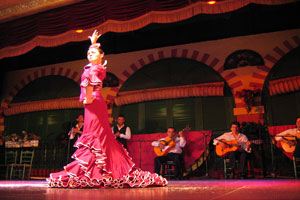
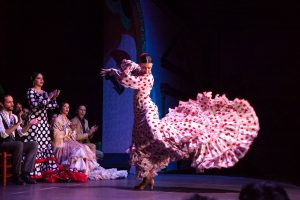
We made reservations to see Tablao Flamenco with Viator Tours at 9:30 pm, including an evening city tour, flamenco show, and dinner and drinks. The dancers wore bright, colorful costumes and danced Spanish flamenco style moves for 2-hours. We truly enjoyed the show!
- Hours: 7:30 pm or 9:30 pm performance
- Cost: $60 per person
- Tour: GetYourGuide
As you can see, there is so much to see in Seville. Spanish culture is festive, social, and romantic. The people were friendly, and the weather is perfect for sightseeing. Performances such as the Flamenco Show, or attending a bullfight, professional soccer match, or paddleboard the Guadalquivir River are many of the activities you can experience. I am sure you will find something that fits your fancy! Witness the incandescent beauty of Seville.
Enjoy your travels! Please read my blogs about other exciting places around the world at Traveling Lens Photography.
If you want to read more about Antalya, follow me on Facebook, Instagram, or Pinterest as I share my journey.
Inshallah (God willing!)





